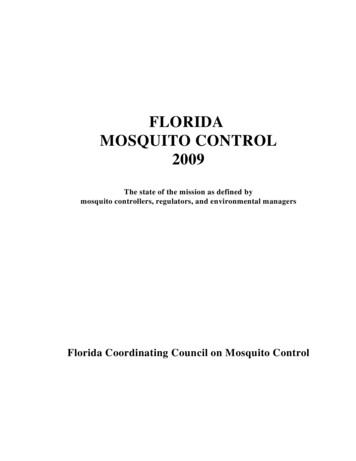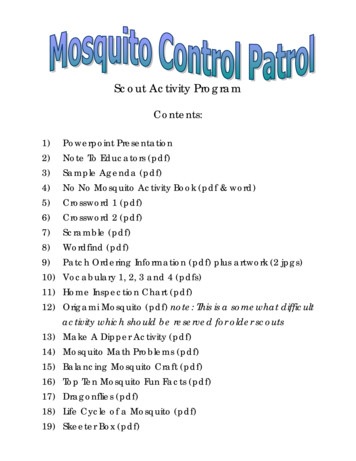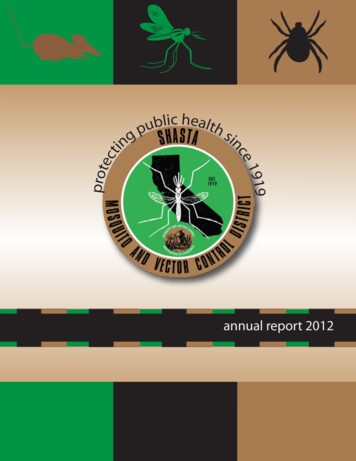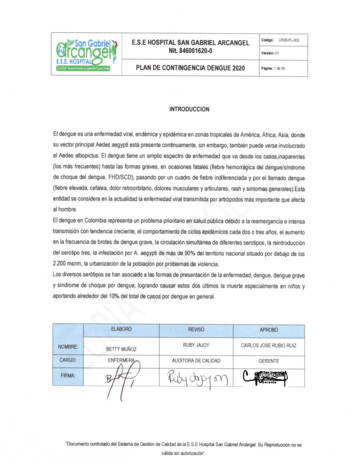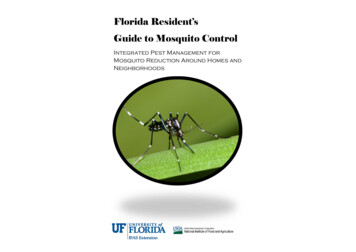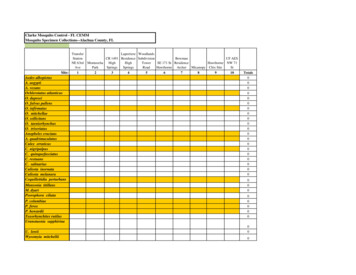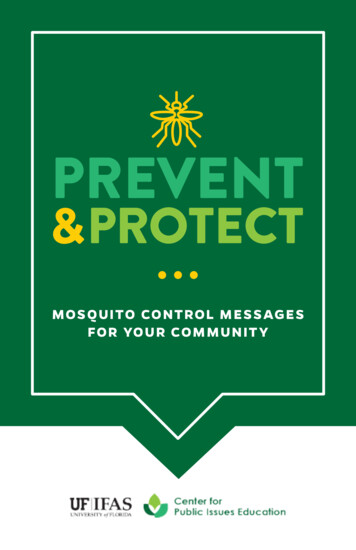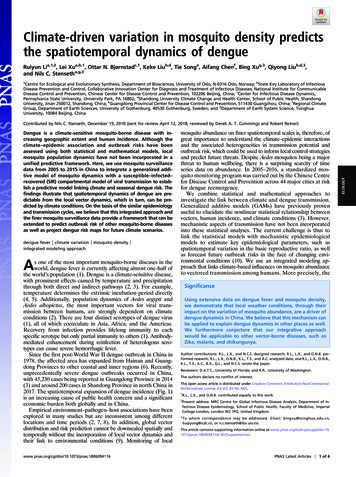
Transcription
Climate-driven variation in mosquito density predictsthe spatiotemporal dynamics of dengueRuiyun Lia,1,2, Lei Xua,b,1, Ottar N. Bjørnstadc,1, Keke Liub,d, Tie Songe, Aifang Chenf, Bing Xug,3, Qiyong Liub,d,3,and Nils C. Stensetha,g,3aCentre for Ecological and Evolutionary Synthesis, Department of Biosciences, University of Oslo, N-0316 Oslo, Norway; bState Key Laboratory of InfectiousDisease Prevention and Control, Collaborative Innovation Center for Diagnosis and Treatment of Infectious Diseases, National Institute for CommunicableDisease Control and Prevention, Chinese Center for Disease Control and Prevention, 102206 Beijing, China; cCenter for Infectious Disease Dynamics,Pennsylvania State University, University Park, PA 16802; dShandong University Climate Change and Health Center, School of Public Health, ShandongUniversity, Jinan 250012, Shandong, China; eGuangdong Provincial Center for Disease Control and Prevention, 511430 Guangzhou, China; fRegional ClimateGroup, Department of Earth Sciences, University of Gothenburg, 40530 Gothenburg, Sweden; and gDepartment of Earth System Science, TsinghuaUniversity, 10084 Beijing, ChinaDengue is a climate-sensitive mosquito-borne disease with increasing geographic extent and human incidence. Although theclimate–epidemic association and outbreak risks have beenassessed using both statistical and mathematical models, localmosquito population dynamics have not been incorporated in aunified predictive framework. Here, we use mosquito surveillancedata from 2005 to 2015 in China to integrate a generalized additive model of mosquito dynamics with a susceptible–infected–recovered (SIR) compartmental model of viral transmission to establish a predictive model linking climate and seasonal dengue risk. Thefindings illustrate that spatiotemporal dynamics of dengue are predictable from the local vector dynamics, which in turn, can be predicted by climate conditions. On the basis of the similar epidemiologyand transmission cycles, we believe that this integrated approach andthe finer mosquito surveillance data provide a framework that can beextended to predict outbreak risk of other mosquito-borne diseasesas well as project dengue risk maps for future climate scenarios. dengue fever climate variationintegrated modeling approach mosquito density As one of the most important mosquito-borne diseases in theworld, dengue fever is currently affecting almost one-half ofthe world’s population (1). Dengue is a climate-sensitive disease,with prominent effects caused by temperature and precipitationthrough both direct and indirect pathways (2, 3). For example,temperature determines the extrinsic incubation period directly(4, 5). Additionally, population dynamics of Aedes aegypti andAedes albopictus, the most important vectors for viral transmission between humans, are strongly dependent on climateconditions (2). There are four distinct serotypes of dengue virus(1), all of which cocirculate in Asia, Africa, and the Americas.Recovery from infection provides lifelong immunity to eachspecific serotype but only partial immunity to others (1). Antibodymediated enhancement during reinfection of heterologous serotypes can cause severe hemorrhagic fever.Since the first post-World War II dengue outbreak in China in1978, the affected area has expanded from Hainan and Guangdong Provinces to other coastal and inner regions (6). Recently,unprecedentedly severe dengue outbreaks occurred in China,with 45,230 cases being reported in Guangdong Province in 2014(3) and around 200 cases in Shandong Province in north China in2017. The spatiotemporal expansion of dengue incidence (Fig. 1)is an increasing cause of public health concern and a significanteconomic burden both globally and in China.Empirical environment–pathogen–host associations have beenexplored in many studies but are inconsistent among differentlocations and time periods (2, 7, 8). In addition, global vectordistribution and risk prediction cannot be downscaled spatially andtemporally without the incorporation of local vector dynamics andtheir link to environmental conditions (9). Monitoring of osquito abundance on finer spatiotemporal scales is, therefore, ofgreat importance to understand the climate–epidemic interactionsand the associated heterogeneities in transmission potential andoutbreak risk, which could be used to inform local control strategiesand predict future threats. Despite Aedes mosquitos being a majorthreat to human wellbeing, there is a surprising scarcity of timeseries data on abundance. In 2005–2016, a standardized mosquito monitoring program was carried out by the Chinese Centrefor Disease Control and Prevention across 44 major cities at riskfor dengue reemergence.We combine statistical and mathematical approaches toinvestigate the link between climate and dengue transmission.Generalized additive models (GAMs) have previously provenuseful to elucidate the nonlinear statistical relationship betweenvectors, human incidence, and climate conditions (3). However,mechanistic aspects of transmission have not been incorporatedinto these statistical analyses. The current challenge is thus tolink the statistical models with mechanistic epidemiologicalmodels to estimate key epidemiological parameters, such asspatiotemporal variation in the basic reproductive ratio, as wellas forecast future outbreak risks in the face of changing environmental conditions (10). We use an integrated modeling approach that links climate-based influences on mosquito abundanceto vectored transmission among humans. More precisely, theSignificanceUsing extensive data on dengue fever and mosquito density,we demonstrate that local weather conditions, through theirimpact on the variation of mosquito abundance, are a driver ofdengue dynamics in China. We believe that this mechanism canbe applied to explain dengue dynamics in other places as well.We furthermore conjecture that our integrative approachwould be applicable to other vector-borne diseases, such asZika, malaria, and chikungunya.Author contributions: R.L., L.X., and N.C.S. designed research; R.L., L.X., and O.N.B. performed research; R.L., L.X., O.N.B., K.L., T.S., and A.C. analyzed data; and R.L., L.X., O.N.B.,K.L., T.S., A.C., B.X., Q.L., and N.C.S. wrote the paper.Reviewers: D.A.T.C., University of Florida; and R.R., University of Washington.The authors declare no conflict of interest.This open access article is distributed under Creative Commons Attribution-NonCommercialNoDerivatives License 4.0 (CC BY-NC-ND).1R.L., L.X., and O.N.B. contributed equally to this work.2Present address: MRC Centre for Global Infectious Disease Analysis, Department of Infectious Disease Epidemiology, School of Public Health, Faculty of Medicine, ImperialCollege London, London W2 1PG, United Kingdom.3To whom correspondence may be addressed. Email: bingxu@tsinghua.edu.cn,liuqiyong@icdc.cn, or n.c.stenseth@ibv.uio.no.This article contains supporting information online at 116/-/DCSupplemental.PNAS Latest Articles 1 of 6ECOLOGYContributed by Nils C. Stenseth, December 19, 2018 (sent for review April 12, 2018; reviewed by Derek A. T. Cummings and Robert Reiner)
have potential for projecting future risk in the face of a changingenvironment.ResultsClimate–Mosquito Associations. We found a significant associationFig. 1. Spatial and temporal distribution of dengue human incidence in2005–2015. (A) Times series of the dengue human incidence in China (on thelogarithmic scale) is projected to (B) case numbers and distinguished by coloraccording to the magnitude in each city.long-term mosquito surveillance data from China are incorporatedin a generalized additive time series model to establish a predictiveclimate–mosquito association using Mi, j ai, j b Lonj , Latj c Ti 1, j d Pi 1, j , by Area «i, j ,[1]where Mi,j is the mosquito abundance in month i in city j. Theparameter ai,j is the overall intercept, and bðLonj , Latj Þ is a twodimensional smooth function accounting for spatial heterogeneity. The mean temperature and the number of precipitating daysin the last month [cðTi 1, j Þ and dðPi 1, j Þ, respectively] are used toincorporate 1-mo lag correlation between mosquito density andmeteorological variables. Area is the categorical factor that classifies cities into north ( 32 N), middle (28 N to 32 N), andsouth ( 28 N) China to represent the differing effects of precipitation on mosquito density across areas. The «i, j representsmodel error with an autoregressive structure to account for theserial dependence in time series data.The climate-driven variation in mosquito density is posited asa proxy for transmission rate of dengue in an epidemiologicalsusceptible–infected–recovered (SIR) model described by thefollowing equations:between mosquito density and local climate conditions in theprevious month, with somewhat differing precipitation–abundance associations among the three regions of China (Fig. 2).The precipitation–abundance association is generally increasing inall areas. The nonlinear association in the northern and middleregions indicates that precipitation is of the greatest impact around15 d/mo (F1.85, 31.8 25.89, P 0.05), whereas the approximatelylinear relationship (F1, 31.8 25.22, P 0.05) indicates that allprecipitation leads to increased mosquito abundance in the southern region. The overall dryer climate in the northern area results ina lower number of precipitating days and hence, a greater uncertainty in estimates of the partial effect of precipitation on mosquito density. We also found a nonlinear but generally increasingassociation between mean temperature in the previous month andmosquito density (F1.97, 31.8 229.09, P 0.05).The statistical model captures the dynamics of the observed mosquito abundance across 26 selected cities throughout the 2006–2015period (SI Appendix, Fig. S1) and reveals strong seasonality andgeographical variability (SI Appendix, Fig. S2). More specifically,there is a general increase in abundance from July to October,reaching the peak magnitude around August. However, the extent ofthe surge of mosquitos differed among cities, with the most prominentincrease in the southern and eastern areas (i.e., Guangdong, Hainan,Zhejiang, and Shandong Provinces). We incorporated biweekly variation in mosquito density during 2005–2015 for the eight representative cities in our mathematical model (SI Appendix, Fig. S3).The 1-mo lag association between local weather condition andmosquito abundance was further validated by the comparison of alternative assumptions. The findings (SI Appendix, Table S1) demonstrate that local weather conditions in the contemporary monthand 2 mo ago do not have a significant impact on mosquitodSβ′ðtÞM SI dtN[2]dI β′ðtÞM SI γIdtN[3]dR γI,dt[4]where S, I, and R are the numbers of susceptible, infectious, andrecovered humans, respectively. N is human population size, and Mis the biweekly mosquito density estimated using the GAM statistical model; 1/γ is the mean infectious period, and β′(t) is the permosquito vector efficiency. We allow for smooth seasonal variationin β′(t) to accommodate factors, such as seasonal variation in mosquito age structure. When incorporated in a mechanistic compartmental model, we find a correspondence between predicted andobserved outbreak trajectories of most major dengue outbreaksacross multiple years and cities; the analysis reveals importantclimate-driven variation in dengue’s basic reproductive ratioin space and time. We thus clarify the extent to which the synthesis of mosquito surveillance data and an integrated modeling framework can capture and predict dengue human cases.Our findings demonstrate that the long-term city-level mosquitosurveillance data are reliable for inferring dengue cases and2 of 6 www.pnas.org/cgi/doi/10.1073/pnas.1806094116Fig. 2. Partial effect from temperature and precipitation on mosquitodensity. The potential nonlinear effects of the number of precipitating daysin (A) north, (B) middle, and (C) south China and (D) mean temperature inthe previous month on mosquito density are quantified using GAM. Resultsof the significance test are also shown for each partial effect of climatepredictor on mosquito density.Li et al.
density, which verifies the correspondence between mosquitoabundance and weather condition in the last month.ECOLOGYPredicting Human Incidence. To link mosquito abundance to humantransmission, we assume a seasonal compartmental SIR model forwhich the transmission rate is driven by vector abundance. Thefitted incidence matches the dynamics of observed human cases well(Fig. 3 and SI Appendix, Fig. S4). Our climate-driven models thusaccurately characterize human risk across a range of magnitudes indifferent years and cities, including the large outbreak in Guangzhou in 2014. In addition, the inferred annual cycle of epidemicdynamics among most cities is similar in terms of vector efficiencyand basic reproductive ratio during the 10-y period. Precisely, theanalysis further reveals seasonality in the per mosquito transmissionrate, reaching a maximum between the middle of July and lateSeptember across most cities (SI Appendix, Fig. S5). Notably, seasonal variation in R0 shows that the epidemic season (when R0 1) lasts for 4–5 mo, typically starting in May (9th to 11th biweek)and ending in the middle of September to October (19th to 21stbiweek) depending on year and city (Fig. 4). Despite the generallyconcordant patterns, there is evidence of comparatively highervector efficiency in Shantou and a shorter epidemic period/lessprobability of widespread transmission in Shenzhen, even whendifferences in mosquito abundance are accounted for. It is alsoworth noting that the relative effect of mosquito abundance andvector efficiency in regulating transmission risk is distinct acrossyears and cities (SI Appendix, Fig. S6). Specifically, mosquitoabundance is the dominant driver of human incidence before 2013in Guangzhou, Foshan, and Xishuangbanna. Conversely, increase inper mosquito transmission rate seems to drive the increase in riskduring 2013–2014. In particular, transmission risk in Guangzhou in2014 is shaped by significant increase in vector efficiency, indicatinga role of factors other than local weather conditions in mediatingtransmission and inducing that particularly explosive outbreak.To test our model’s ability to perform out-of-sample predictions, we used models trained on the 2005–2014 portion of thedata to predict the 2015 outbreaks. There is generally a closematch between the predicted and observed dengue cases wherethe overall trajectory and relative magnitudes of outbreaks indifferent cities are captured (Fig. 3 and SI Appendix, Fig. S4).The validation of our proposed SIR mechanism that local weatherconditions drive dengue dynamics through their impact on mosquitoFig. 3. Observed and predicted dengue human cases across various cities between 2005–2015. The observed number of human cases in outbreak years (thegray shaded area) during 2005–2014 is used for model simulation and parameter estimation. The model was reinitialized using a plausible range of infectiousperiods at the beginning of each outbreak year. The median estimates of human cases (red lines) and corresponding confidence intervals (red shaded area)for both simulation and forecasts were compared with observed data (black lines) on the logarithmic scale.Li et al.PNAS Latest Articles 3 of 6
Fig. 4. The dynamics of R0 during 2005–2014. The median estimates and thecorresponding 5th and 95th quantile intervals represent the seasonality ofthe human-to-human basic reproductive rate in each city in 2005–2014.abundance with a 1-mo lag was done through comparison with theperformance of the alternative hypotheses and mechanisms. Ourclimate–epidemic model has a better root mean square error(RMSE) than the null model, where mosquito abundance was notincorporated (SI Appendix, Fig. S7). This finding demonstrates that a“vector-free” model with a simple spline-fitted transmission ratecannot accurately capture the complex interactions at the climate–mosquito–virus interface. Therefore, an alternative hypothesis thatassumes a direct impact of climate factors on transmission rate doesnot perform well in characterizing dengue transmissions. Additionally, statistical testing verifies the significant outperformance of thetime-dependent vector model over the alternative constant vectorefficiency (SI Appendix, Table S2). That is, seasonal variationof mosquito abundance alone cannot fully characterize themosquito–human interactions as well, which is presumably dueto the seasonality in human/mosquito activity patterns as well asshifts in vector age structure (11).DiscussionIn our study, long-term mosquito surveillance data from manyChinese cities are incorporated in the analysis of a vector-bornehuman infection. The seasonality of R0 generally follows theclimate-driven dynamics of mosquito abundance, which remain at ahigher level from May/June to September/October. This findingclarifies how local mosquito abundance combined with variousother seasonal factors may cause explosive dengue risk to humans.Our findings further highlight the importance of city-level mosquitosurveillance data integrated with a synthetic mathematical framework to successfully predict dengue risk.Our integrated modeling approach improves inference on denguetransmission at the climate–epidemic interface. Moreover, the statistical model allows prediction of the temporal dynamics of mosquitoabundance in locations where no or only partial monitoring is available. The improved mosquito estimates not only make up for thesurveillance bias but also, allow prediction of seasonal dynamics of human cases when used to force an SIR compartmentalmodel. The seasonality in transmission rate is likely to reflect theeffects of multiple factors and complex interactions at the mosquito–human interface that impact dengue risk through heterogeneous4 of 6 isms at various spatial–temporal scales (12). More specifically, we found that local weather conditions directly regulateadult mosquito density through variation in precipitation andtemperature with a roughly 1-mo lag. However, effects of otherclimate and nonclimate factors on dengue risk may be exerted overlonger periods of time and across other spatial scales. For example,previous studies have documented a significant coherence betweenthe interannual dynamics of El Niño–Southern Oscillation-relatedclimate anomalies and dengue incidence in countries, such asThailand, Mexico, and some island nations of the South Pacific(13–16). Some nonclimatic drivers, such as human movements,have also been documented to mediate exposure risk to vectors,dengue transmission rates, and spatial patterns at finer scales (17,18). The validation of our proposed modeling framework furtherindicates that the complex interactions underlying dengue transmission can only be accurately characterized by considering mosquito abundance and seasonality in vector efficiency. The latterplausibly comes about because of the extrinsic incubation period aswell as adult mosquito age structure variations throughout theyear. This model’s outperformance in inferring dengue risk maypartially be explained by the multiple ways that climate influencestransmission. Put another way, by independently simulating thenonlinear variation in mosquito abundance and vector efficiency,the multiple sources of seasonality are better characterized, leadingto better inference on human risk. In contrast, alternative modelsthat assume either a direct climate impact on transmission or aconstant vector efficiency are not adequate for predicting the interactions at the climate–vector–dengue interface. Notably, theoutperformance of this proposed climate–mosquito–epidemicmechanism in driving dengue dynamics should not be interpretedas the consistent pathway but should be verified spanning differenttransmission settings and spatiotemporal scales.Some limitations should be taken into consideration when interpreting our studies. Themed around climate–mosquito associations,our inference on dengue risk should be interpreted as an outbreakpotential caused by local climate and mosquito conditions. This isbecause current mosquito control strategies are increasingly effectivein reducing the risk of human infections (1), particularly after theoccurrence of the big outbreak in Guangzhou in 2014. Such controlswill alter the suitable transmission condition and potential transmission bounds set by climate alone. The human risk is alsolikely underestimated, because asymptomatic infections are notincluded in our analysis. Therefore, additional research isneeded to quantify the relative contribution of other determinants of risk in modulating transmission condition and humanrisk in each city to make more accurate forecasts across differentgeographical locales. Additionally, potential bias in mosquitosurveillance may affect the spatiotemporal surveillance of mosquito abundance. The large variation in mosquito abundancewithin cities reflects both the seasonality of the mosquito population and the role of mosquito surveillance in guiding controlstrategies. Specifically, seasonal dynamics of mosquito densityfollow the fluctuation of local climate conditions, with peakabundance in the summer. The heterogeneous control strategiesacross cities and specific surveillance sites may lead to anomalous fluctuations in mosquito density (SI Appendix, Fig. S2).Generally, southern cities are of higher risk and hence, havemore intensified prevention and control routines, whereasnorthern cities tend to have moderate controls only after theoccurrence of outbreaks. Likewise, mosquito abundance in newlyselected surveillance sites may be higher due to a lack of previousinterventions. Moreover, the selection of 1-mo lag in weather–abundance association is dependent on the mosquito lifecycle.In light of the lower proportion of explained deviation and ahigher generalized cross-validation criteria (GCV) value compared with the 1-mo lag model, the additional incorporation ofmeteorological factors in contemporary month and 2 mo agodoes not have significant impact on mosquito abundance.Li et al.
MethodsDengue Human Cases. Case-level records of dengue human data from January2005 to December 2015 in China were obtained from the China NationalNotifiable Disease Surveillance System. The associated information of eachcase, including age, sex, occupation, date of onset, and description abouttravel or contact history, was also collected. Biweekly human cases weresummarized for the mathematical modeling analysis.Mosquito Surveillance Data. Mosquito surveillance of both A. aegypti and A.albopictus from January 2005 to December 2015 was implemented by theChinese Center for Disease Control and Prevention using light traps. Theselection of representative trap sites was based on local mosquito breedingecosystems, epidemic areas, and feasibility of surveillance, and sites includedhouseholds, residential areas, parks, construction sites, and hospitals. Specifically, a light trap was placed at the sheltered site away from light and 1.5 m above the ground. The light was on, and surveillance was performedat night from 1 h before sunset to 1 h after sunrise. Traps were collected daily,and mosquitoes were collected for subsequent analyses, including the identification of species, sexing, and total count. Since A. aegypti is the dominantspecies in most cities (SI Appendix, Table S3), we aggregated the number ofthe two species, with the assumption of similar viral transmission ability of thetwo. The monthly number of mosquitoes was transformed to monthly mosquito density (unit: number of mosquitoes per trap). The number of monitored cities increased from 32 to 44 during 2006–2015, among which theobserved mosquito density in 26 cities was greater than zero. These were usedfor additional statistical modeling (SI Appendix, Fig. S8).Local Meteorological Variables. Daily mean temperature and precipitationdata during 2005–2015 were obtained from the China Meteorological DataSharing Service System (data.cma.cn; last accessed January 29, 2018). Theobtained meteorological dataset was processed into monthly mean temperature and the number of precipitating days (number of days with precipitation over 1 mm/d) (19) to reconstruct the mosquito density in thestatistical analysis.Statistical Analysis. GAMs with a negative binomial distribution andautoregressive error term were used to study the association betweenlocal weather conditions and mosquito population dynamics according toEq. 1. The analyses were implemented using the mgcv package in R.Based on the lifecycle of the mosquito, we posited a 1-mo lag betweenadult mosquito abundance and meteorological variables. That is, weassumed that the adult mosquito density is related with a time lag to thepremature stages, which are directly influenced by meteorological factors.Therefore, the mean temperature and the number of precipitating days in thelast month [i.e., cðTi 1, j Þ and dðPi 1, j , by AreaÞ] were used to predict mosquito density in the current month. In light of the differential impact ofprecipitation in different climate regions in China (20–22), a smooth functionwith a categorical indicator (i.e., Area) was chosen for precipitation to allowfor a heterogeneous precipitation–abundance association. Specifically, 26mosquito surveillance sites were located in the east monsoon area whereregional climate was greatly influenced by precipitation and temperature,with the strongest seasonality in the middle and lower reaches of the YangtzeRiver (28 N to 32 N). Therefore, we assigned surveillance sites to three different climate subareas: the north ( 32 N), middle (28 N to 32 N), and south( 28 N) China.1. WHO (2017) Dengue and serve dengue. Available at l/dengue-and-severe-dengue. Accessed January 29, 2018.2. Morin CW, Comrie AC, Ernst K (2013) Climate and dengue transmission: Evidence andimplications. Environ Health Perspect 121:1264–1272.3. Xu L, et al. (2017) Climate variation drives dengue dynamics. Proc Natl Acad Sci USA 114:113–118.4. McLean DM, et al. (1974) Vector capability of Aedes aegypti mosquitoes for California encephalitis and dengue viruses at various temperatures. Can J Microbiol20:255–262.Li et al.We first calibrated the model and obtained empirical climate–mosquito associations using both monthly mosquito density and meteorological data at 26surveillance sites during 2006–2015. This association was then interpolated toget the biweekly mosquito estimates for the period of 2005–2015, which weresequentially used as the proxy of transmission rate among humans in themathematical model (see below). To further validate the assumption of a 1-molag in weather–abundance association, model performance with alternativeassumptions (i.e., mosquito abundance is correlated to the weather condition inthe contemporary month or the last 2 mo) was evaluated and compared usingthe GCV. The alternatives provided weaker fits.The epidemical SIR model used for this study simulates dengue transmissionamong humans. The model is described by the SIR equations (Eqs. 2–4).The mean infectious period, 1/γ, was taken as a random constant from theuniform distribution of 14–18 d as the extrinsic incubation period and theaverage intrinsic incubation periods 8–12 and 6 d. β′(t), the per mosquitotransmission rate or the vector efficiency, is the time-dependent scalingfactor linking the estimated mosquito density with transmission amonghumans, β(t). More specifically, our modeling framework was implementedwith the assumption that the variation of mosquito density over time ishighly linked to and can be used as a proxy for the dynamics of transmissionamong humans. Hence, the transmission rate among humans and human andto-human basic reproductive ratio are calculated as βðtÞ β’ðtÞMR0 βðtÞM γ, respectively. On the basis of the complex interactions at themosquito–human interface, we used a spline function with three degrees offreedom to estimate the seasonality in vector efficiency, β′(t).The numbers of human cases in outbreak years (or years with prominentmagnitude of human cases) during 2005–2014 in eight representative cities(SI Appendix, Fig. S9) were selected for SIR model simulation and parameterestimation. With the assumption of a homogeneous susceptibility in theentire population and no underreporting of cases, we reinitialized themodel 500 times with different γ values at the beginning of each outbreakyear to simulate human incidence. The median estimates of all simulationsusing the varying γ values are presented. Based on the similarity in localbiological and ecological conditions cross-years, dynamics of vector efficiency in 2015 were assumed to follow the general dynamic pattern of thoseduring the previous outbreak years in each city. Therefore, the 10-y averaged dynamics of β′(t) obtained from model simulation and estimatedmosquito abundance were used to forecast human dengue cases in 2015.The performance of the SIR model was quantified by the root mean squarederror. Additionally, the relative effect of mosquito density and vector efficiencyon dengue risk was evaluated by the correlation between the fluctuation of R0,mosquito abundance, and vector efficiency. Precisely, 10-y averaged values ofR0, mosquito abundance, and efficiency were subtracted to estimate thefluctuation at each biweek relative to the long-term dynamic pattern in a city.The relative contribution of the fluctuation of mosquito abundance and efficiency was subsequently identified by univariate and multivariate correlationanalyses. To validate the proposed m
Climate-driven variation in mosquito density predicts the spatiotemporal dynamics of dengue Ruiyun Lia,1,2, Lei Xua,b,1, Ottar N. Bjørnstadc,1, Keke Liub,d, Tie Songe, Aifang Chenf, Bing Xug,3, Qiyong Liub,d,3, and Nils C. Stensetha,g,3 aCentre for Ecological and Evolutionary Synthesis, Department of Biosciences, University of Oslo, N-0316 Oslo, Norway; bState Key Laboratory of Infectious

